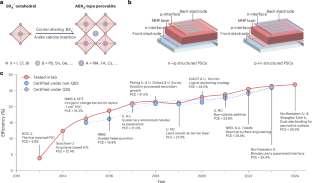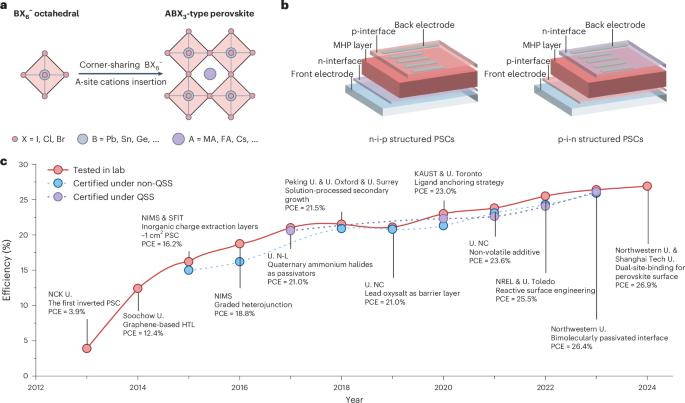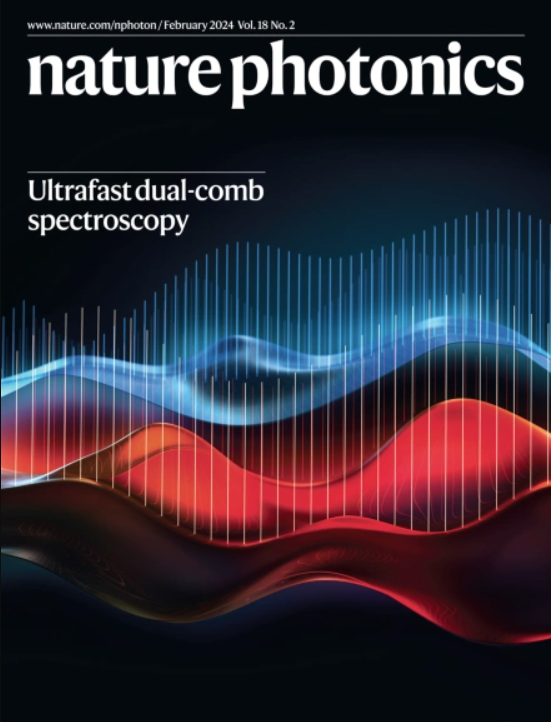倒置型过氧化物太阳能电池的进展
IF 32.3
1区 物理与天体物理
Q1 OPTICS
引用次数: 0
摘要
目前正在大力推进反向(p-i-n)包晶石太阳能电池(PSCs)的发展。一些钝化和绝缘策略已得到有效应用,以减少非辐射重组,这是 PSCs 的一个臭名昭著的问题。因此,倒置型 PSC 的性能已开始与普通(n-i-p)PSC 相媲美,功率转换效率(PCE)值超过 26%。含有倒置 PSC 子电池的串联太阳能电池的效率也迅速提高,达到了 33%。本综述讨论了 PSC 中非辐射重组的起源以及在减少非辐射重组方面的最新进展。我们回顾了创新的器件配置、包晶石成分和界面工程如何有助于提高倒置式 PSCs 的效率和长期运行稳定性。我们旨在为读者提供有关材料化学、物理加工和器件配置的重要见解,以进一步改进基于包晶石的光伏技术。本文章由计算机程序翻译,如有差异,请以英文原文为准。


Advances in inverted perovskite solar cells
Considerable efforts are being made to advance inverted (p–i–n) perovskite solar cells (PSCs). Several passivation and insulation strategies have effectively been applied to reduce non-radiative recombination, a notorious issue for PSCs. Consequently, the performance of inverted PSCs has begun to rival those of regular (n–i–p) PSCs, with power conversion efficiency (PCE) values above 26%. The efficiency of tandem solar cells containing an inverted PSC as a subcell has also grown rapidly, reaching >33%. This Review discusses the origin of non-radiative recombinations in PSCs and recent progress in reducing them. We review how innovative device configurations, perovskite composition and interfacial engineering contribute to the high efficiency and long-term operational stability of inverted PSCs. We aim to provide readers with important insights into materials chemistry, physical processing and device configurations to further improve perovskite-based photovoltaics. The authors review recent advances in inverted perovskite solar cells, with a focus on non-radiative recombination processes and how to reduce them for highly efficient and stable devices.
求助全文
通过发布文献求助,成功后即可免费获取论文全文。
去求助
来源期刊

Nature Photonics
物理-光学
CiteScore
54.20
自引率
1.70%
发文量
158
审稿时长
12 months
期刊介绍:
Nature Photonics is a monthly journal dedicated to the scientific study and application of light, known as Photonics. It publishes top-quality, peer-reviewed research across all areas of light generation, manipulation, and detection.
The journal encompasses research into the fundamental properties of light and its interactions with matter, as well as the latest developments in optoelectronic devices and emerging photonics applications. Topics covered include lasers, LEDs, imaging, detectors, optoelectronic devices, quantum optics, biophotonics, optical data storage, spectroscopy, fiber optics, solar energy, displays, terahertz technology, nonlinear optics, plasmonics, nanophotonics, and X-rays.
In addition to research papers and review articles summarizing scientific findings in optoelectronics, Nature Photonics also features News and Views pieces and research highlights. It uniquely includes articles on the business aspects of the industry, such as technology commercialization and market analysis, offering a comprehensive perspective on the field.
 求助内容:
求助内容: 应助结果提醒方式:
应助结果提醒方式:


